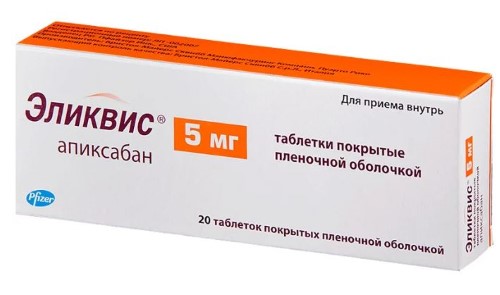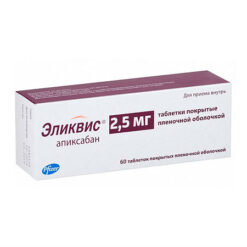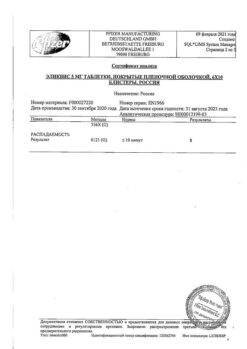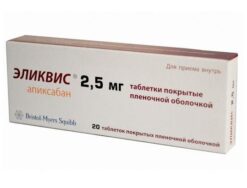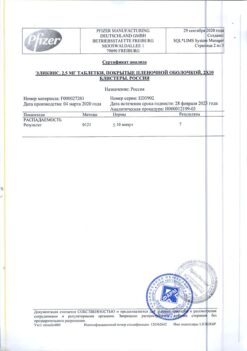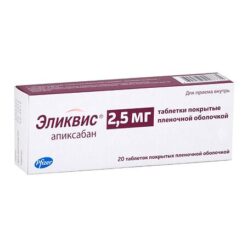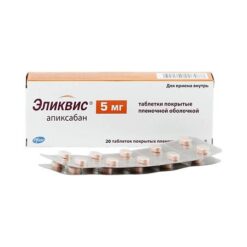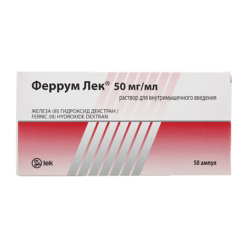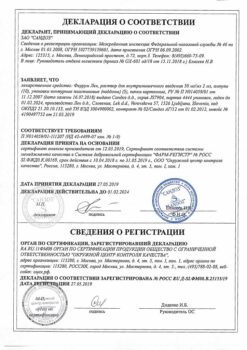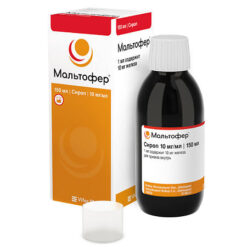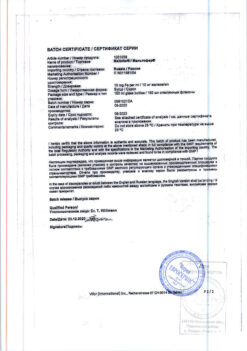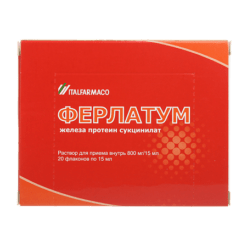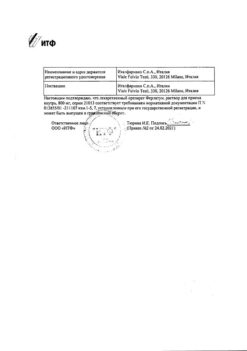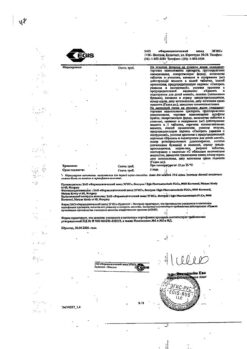No products in the cart.
Eliquis, 5 mg 20 pcs.
€24.11 €20.09
Description
A direct-acting anticoagulant is a selective inhibitor of factor Xa clotting.
The mechanism of action of apixaban is inhibition of FXa activity. As a result, apixaban changes values of indexes of blood coagulation system: prolongs prothrombin time, MHO and activated partial thromboplastin time (APTB). Changes of these parameters when using the drug in a therapeutic dose are insignificant and individual. Therefore, their use to assess pharmacodynamic activity of apixaban is not recommended.
The inhibition of FXa activity by apixaban has been proven by a chromogenic test using Rotachrom heparin. The change in anti-FXa activity is directly proportional to the increase in plasma apixaban concentration, with maximum activity values observed when Cmax apixaban in plasma is reached.
Linear relationship between the concentration and anti-FXa activity of apixaban is registered in a wide range of therapeutic doses of the drug. Changes in anti-FXa activity with changes in apixaban dose and concentration are more pronounced and less variable than blood clotting parameters.
The expected maximum and minimum anti-FXa activity of apixaban at equilibrium, when administered at a dose of 2.5 mg 2 times/day, is 1.ZMe/ml (5/95 percentile – 0.67 IU/ml to 2.4 IU/ml) and 0.84 IU/ml (5/95th percentile -0.37 IU/ml to 1.8 IU/ml), respectively, which correlates with the variation in this index between doses of the drug (less than 1.6 times).
Apixaban therapy does not require routine monitoring of plasma concentrations, but performing a Rotachrom anti-FXa activity test may be helpful in deciding whether to continue therapy.
Indications
Indications
prevention of venous thromboembolism in patients after planned hip or knee replacement;
prevention of strokes, systemic thromboembolism and reduction of mortality in patients with atrial fibrillation. The exception is patients with severe and moderate mitral stenosis or artificial heart valves.
Pharmacological effect
Pharmacological effect
Direct anticoagulant – selective inhibitor of blood coagulation factor Xa.
The mechanism of action of apixaban is the inhibition of FXa activity. As a result of this, apixaban changes the values of the blood coagulation system: it lengthens prothrombin time, MHO and activated partial thromboplastin time (aPTT). Changes in these indicators when using the drug in a therapeutic dose are insignificant and individual. Therefore, their use to assess the pharmacodynamic activity of apixaban is not recommended.
The inhibition of FXa activity by apixaban has been demonstrated using the heparin Rotachrom chromogenic test. The change in anti-FXa activity is directly proportional to the increase in the concentration of apixaban in the blood plasma, with maximum activity values observed when the Cmax of apixaban in the blood plasma is reached.
A linear relationship between the concentration and anti-FXa activity of apixaban is recorded over a wide range of therapeutic doses of the drug. Changes in anti-FXa activity with changes in apixaban dose and concentration are more pronounced and less variable than blood coagulation parameters.
The expected maximum and minimum anti-FXa activity of apixaban at steady state, when used at a dose of 2.5 mg 2 times / day, is 1.3IU/ml (5/95th percentile – 0.67 IU/ml – 2.4 IU/ml) and 0.84 IU/ml (5/95th percentile -0.37IU/ml – 1.8 IU/ml), accordingly, which correlates with fluctuations in this indicator in the interval between taking doses of the drug (less than 1.6 times).
During apixaban therapy, routine monitoring of its plasma concentrations is not required, but the Rotachrom anti-FXa activity test may be useful in deciding whether to continue therapy.
Special instructions
Special instructions
In patients with atrial fibrillation and conditions requiring the use of monotherapy or combination therapy of two antiplatelet drugs, a careful assessment of the benefit/risk ratio should be carried out before concomitant use with Eliquis.
Eliquis is not recommended for use in patients with liver disease associated with coagulation disorders and a clinically significant risk of bleeding.
It was shown that in high-risk patients following acute coronary syndrome, with multiple cardiac and non-cardiac comorbidities, there was a significant increase in the risk of bleeding when co-administered apixaban and acetylsalicylic acid or a combination of acetylsalicylic acid and clopidogrel compared with placebo.
As with other anticoagulants, patients taking Eliquis should be closely monitored for bleeding. If severe bleeding develops, Eliquis should be discontinued.
If hemorrhagic complications develop, it is necessary to discontinue treatment with the drug and perform an examination to identify the source of bleeding. If necessary, appropriate treatment is prescribed, in particular surgical control of bleeding or transfusion of fresh frozen blood plasma.
Cancellation of anticoagulant therapy, incl. apixaban, with active bleeding before elective surgery or an invasive procedure, may lead to an increased risk of thrombosis. Prolonged discontinuation of therapy should be avoided and if apixaban therapy must be temporarily discontinued, it should be restarted as soon as possible.
Performing spinal, epidural, or puncture in patients receiving Eliquis
When performing spinal or epidural anesthesia or diagnostic puncture of these areas in patients receiving antithrombotic drugs to prevent thromboembolism, there is a risk of developing epidural or spinal hematomas, which, in turn, can cause persistent or irreversible paralysis. This risk may further increase when using an installed epidural catheter in the postoperative period or when using other drugs that affect hemostasis in parallel. Established epidural or subarachnoid catheters should be removed at least 5 hours before the first dose of Eliquis. A similar increase in risk may be observed when performing traumatic or repeated punctures of the epidural or subarachnoid spaces. Frequent monitoring of patients is necessary for the development of manifestations of nervous system dysfunction (in particular, numbness or weakness of the lower extremities, impaired bowel or bladder function).
If such disorders develop, emergency examination and treatment are necessary. Before performing interventions on the epidural or subarachnoid spaces in patients receiving anticoagulants, incl. In order to prevent thrombosis, an assessment of the ratio of potential benefits and risks is necessary.
Impact on the ability to drive vehicles and operate other machinery. Eliquis does not have a significant effect on the ability to drive a car or operate machinery.
Active ingredient
Active ingredient
Apixaban
Composition
Composition
1 tablet contains apixaban 5 mg.
excipients:
Contraindications
Contraindications
hypersensitivity to any component of the drug;
clinically significant bleeding;
severe liver dysfunction;
impaired renal function with Cl creatinine less than 15 ml/min, as well as use in patients on dialysis;
pregnancy;
breast-feeding;
age up to 18 years.
It is not recommended to use apixaban simultaneously with drugs that may be associated with the development of serious bleeding.
With caution: apixaban should be used with caution in patients with moderate to mild hepatic impairment (Child-Pugh class A or B); performing spinal/epidural anesthesia or spinal/epidural puncture (see “Special Instructions”); in patients receiving systemic therapy with potent inhibitors of the CYP3A4 isoenzyme and P-glycoprotein, such as azole antifungals (in particular ketoconazole, itraconazole, voriconazole and posaconazole), HIV protease inhibitors (for example, ritonavir); when using apixaban with powerful inducers of the CYP3A4 isoenzyme and P-glycoprotein (in particular, rifampicin, phenytoin, carbamazepine, phenobarbital or St. John’s wort preparations).
Side Effects
Side Effects
The frequency of adverse reactions means: often – ≥1/100,
Prevention of venous thromboembolism in patients after elective hip or knee replacement
Adverse reactions were reported in 11% of patients receiving apixaban 2.5 mg twice daily. As with other anticoagulants, bleeding may occur in patients with risk factors, such as organic lesions, which may be accompanied by bleeding. The most common side effects were anemia, bleeding, hematomas, and nausea. Adverse reactions that developed in patients undergoing orthopedic surgery during apixaban therapy are presented below.
From the blood and lymphatic system: often – anemia (including postoperative and post-hemorrhagic, accompanied by corresponding changes in laboratory test results), bleeding (including hematoma, vaginal and urethral bleeding); uncommon – thrombocytopenia (including decreased platelet count).
From the immune system: rarely – hypersensitivity.
From the organ of vision: rarely – hemorrhages in the tissue of the eyeball (including hemorrhage in the conjunctiva).
From the cardiovascular system: infrequently – arterial hypotension (including hypotension during the procedure).
From the respiratory system: infrequently – nosebleeds; rarely – hemoptysis.
From the gastrointestinal tract: often – nausea; uncommon – gastrointestinal bleeding (including vomiting mixed with blood and melena), the presence of unchanged blood in the stool; rarely – rectal bleeding, bleeding from the gums.
From the liver and biliary tract: infrequently – increased activity of transaminases, incl. increased activity of ALT, AST, GGTP, pathological changes in liver function tests, increased activity of alkaline phosphatase in the blood, increased concentration of bilirubin in the blood.
From the musculoskeletal system: rarely – muscle hemorrhage.
From the urinary system: infrequently – hematuria (including corresponding changes in laboratory test results).
Other: often – closed injury; uncommon – hemorrhage and bleeding after invasive procedures (including hematoma after the procedure, bleeding from a postoperative wound, hematoma in the area of vascular puncture and at the site of catheter installation), the presence of discharge from the wound, hemorrhage in the incision area (including hematoma in the incision area), bleeding during surgery.
Prevention of strokes and systemic embolism in patients with atrial fibrillation
From the immune system: uncommon – hypersensitivity (including drug hypersensitivity reactions such as skin rash and anaphylactic reactions, allergic edema).
From the nervous system: uncommon – intracranial hemorrhage, subarachnoid hemorrhage, subdural hematoma, hemorrhage into the spinal canal, spinal hematoma.
On the part of the organ of vision: often – hemorrhages in the tissue of the eyeball (including hemorrhage in the conjunctiva).
From the cardiovascular system: often – other types of bleeding, hematomas; infrequently – bleeding into the abdominal cavity.
From the respiratory system: often – nosebleeds; infrequently – hemoptysis; rarely – bleeding into the organs of the respiratory system (including pulmonary alveolar hemorrhage, laryngeal and pharyngeal bleeding).
From the gastrointestinal tract: often – gastrointestinal bleeding (including vomiting mixed with blood and melena), rectal bleeding, bleeding from the gums; uncommon – hemorrhoidal bleeding, the presence of unchanged blood in the stool, bleeding into the oral cavity; rarely – retroperitoneal hemorrhage.
From the urinary system: often – hematuria.
From the reproductive system: infrequently – intermenstrual vaginal bleeding, urogenital bleeding.
Reactions at the injection site: uncommon – bleeding at the injection site.
Laboratory indicators: infrequently – a positive reaction in a stool test for occult blood.
Other: often – closed injury; uncommon – traumatic bleeding, bleeding after the procedure, hemorrhage in the incision area.
Interaction
Interaction
Effect of other drugs on the pharmacokinetics of apixaban
Inhibitors of CYP3A4 and P-glycoprotein. The combination of apixaban with ketoconazole (at a dose of 400 mg, 1 time per day), which is a powerful inhibitor of both the CYP3A4 isoenzyme and P-glycoprotein, led to an increase in the average AUC value of apixaban by 2 times and the average Cmax by 1.6 times. No dosage adjustment of apixaban is required when combined with ketoconazole, but apixaban should be used with caution in patients receiving systemic therapy with azole antifungals, in particular ketoconazole, or other potent inhibitors of the CYP3A4 isoenzyme and P-glycoprotein.
Drugs other than potent inhibitors of CYP3A4 and P-glycoprotein (e.g. diltiazem, naproxen, amiodarone, verapamil, quinidine) are likely to increase plasma concentrations of apixaban to a lesser extent. For example, diltiazem (a moderate CYP3A4 inhibitor and a weak P-glycoprotein inhibitor) at a dose of 360 mg once daily resulted in an increase in mean apixaban AUC values by 1.4 times and mean Cmax values by 1.3 times. Naproxen (a P-glycoprotein inhibitor), when administered at a dose of 500 mg to healthy volunteers, increased the mean AUC and Cmax of apixaban by 1.5 and 1.6 times, respectively. At the same time, there was an increase in the values of blood coagulation parameters (PT, INR and APTT). However, there was no effect of naproxen on arachidonic acid-induced platelet aggregation, nor a clinically significant prolongation of bleeding time.
No dose adjustment of apixaban is required when combined with moderate inhibitors of the CYP3A4 isoenzyme and/or P-glycoprotein.
Inducers of the isoenzyme CYP3A4 and P-glycoprotein. The combination of apixaban with rifampicin (a potent inducer of CYP3A4 and P-glycoprotein) resulted in a decrease in the mean AUC and Cmax of apixaban by approximately 54 and 42%, respectively. Apparently, the combination of apixaban with other potent inducers of the CYP3A4 isoenzyme and P-glycoprotein (in particular phenytoin, carbamazepine, phenobarbital or St. John’s wort preparations) may also lead to a decrease in the concentration of apixaban in the blood plasma. No dose adjustment of apixaban is required when combined with drugs in this group, but these drugs should be combined with caution.
Anticoagulants, platelet aggregation inhibitors and NSAIDs. After co-administration of enoxaparin (single dose, 40 mg) and apixaban (single dose, 5 mg), an additive effect of these drugs on FXa activity was noted.
There were no signs of pharmacokinetic or pharmacodynamic interaction of apixaban with acetylsalicylic acid (at a dose of 325 mg, 1 time per day) in healthy people.
The combination of apixaban with clopidogrel (at a dose of 75 mg, 1 time per day) or a combination of clopidogrel (75 mg) and acetylsalicylic acid (162 mg, 1 time per day) in phase I of the clinical trial did not lead to an increase in bleeding time or further inhibition of platelet aggregation compared with the use of these antiplatelet agents in monotherapy. The increase in blood coagulation parameters (PT, INR and APTT) corresponded to the effects of apixaban when used in monotherapy.
It is not recommended to simultaneously use drugs that may be associated with the development of serious bleeding, such as unfractionated heparin or heparin derivatives (including low molecular weight heparins), oligosaccharides that inhibit FXa (for example fondaparinux), direct thrombin II inhibitors (for example desirudin), thrombolytic drugs, glycoprotein IIb/IIIa receptor antagonists, dipyridamole, dextran, sulfinpyrazone, vitamin K antagonists and other oral anticoagulants. It should be noted that unfractionated heparin can be used in doses necessary to maintain the patency of a central venous or arterial catheter.
In patients undergoing elective hip or knee replacement, co-administration of apixaban with other antiplatelet or antithrombotic drugs is not recommended.
Combination with other drugs. There were no clinically significant pharmacokinetic or pharmacodynamic interactions of apixaban with atenolol or famotidine.
Combining apixaban (at a dose of 10 mg) with atenolol (at a dose of 100 mg) did not lead to the development of clinically significant changes in the pharmacokinetic parameters of apixaban, but it was accompanied by a decrease in the average AUC and Cmax values of apixaban by 15 and 18%, respectively, compared with the monotherapy regimen. Administration of apixaban (10 mg dose) with famotidine (40 mg dose) did not affect the AUC or Cmax values of apixaban.
Effect of apixaban on the pharmacokinetics of other drugs
In in vitro studies, apixaban did not inhibit the activity of the CYP1A2, CYP2A6, CYP2B6, CYP2C8, CYP2C9, CYP2D6 or CYP3A4 isoenzymes (inhibitory concentration (IC50) >45 μmol/L) and at the same time weakly suppressed the activity of the CYP2C19 isoenzyme (IC50 >20 μmol/L) in a concentration significantly exceeding the Cmax of the drug in the blood plasma at its clinical application. Apixaban is not an inducer of the isoenzymes CYP1A2, CYP2B6, CYP3A4/5 at concentrations up to 20 µmol/l. In this regard, it is expected that when used together it will not affect the clearance of drugs metabolized by these isoenzymes. In addition, apixaban does not significantly inhibit P-glycoprotein activity. In studies in healthy volunteers, apixaban did not significantly alter the pharmacokinetics of digoxin, naproxen, or atenolol.
Overdose
Overdose
Symptoms: the risk of bleeding increases. In controlled clinical studies, apixaban was administered orally to healthy volunteers in doses up to 50 mg/day for 3–7 days (25 mg, twice daily for 7 days or 50 mg, once daily for 3 days); There were no clinically significant undesirable effects.
Treatment: Activated carbon may be considered. The antidote for the drug is unknown.
Storage conditions
Storage conditions
At a temperature not exceeding 30 °C
Shelf life
Shelf life
3 years
Manufacturer
Manufacturer
Bristol-Myers Squibb Manufacturing Company, Puerto Rico
Additional information
| Shelf life | 3 years |
|---|---|
| Conditions of storage | At a temperature not exceeding 30 °C |
| Manufacturer | Bristol-Myers Squibb Manufacturing Company, Puerto Rico |
| Medication form | pills |
| Brand | Bristol-Myers Squibb Manufacturing Company |
Other forms…
Related products
Buy Eliquis, 5 mg 20 pcs. with delivery to USA, UK, Europe and over 120 other countries.

